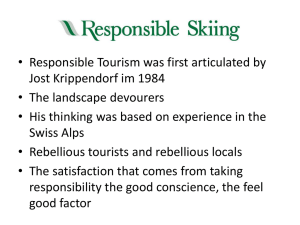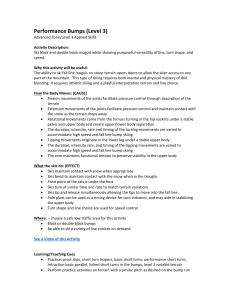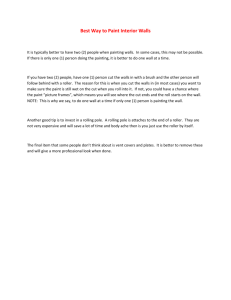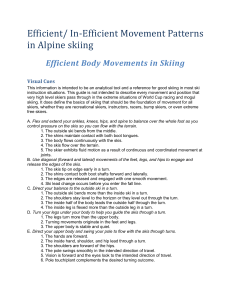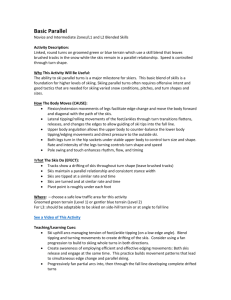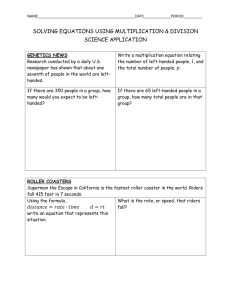Roller Skis
advertisement
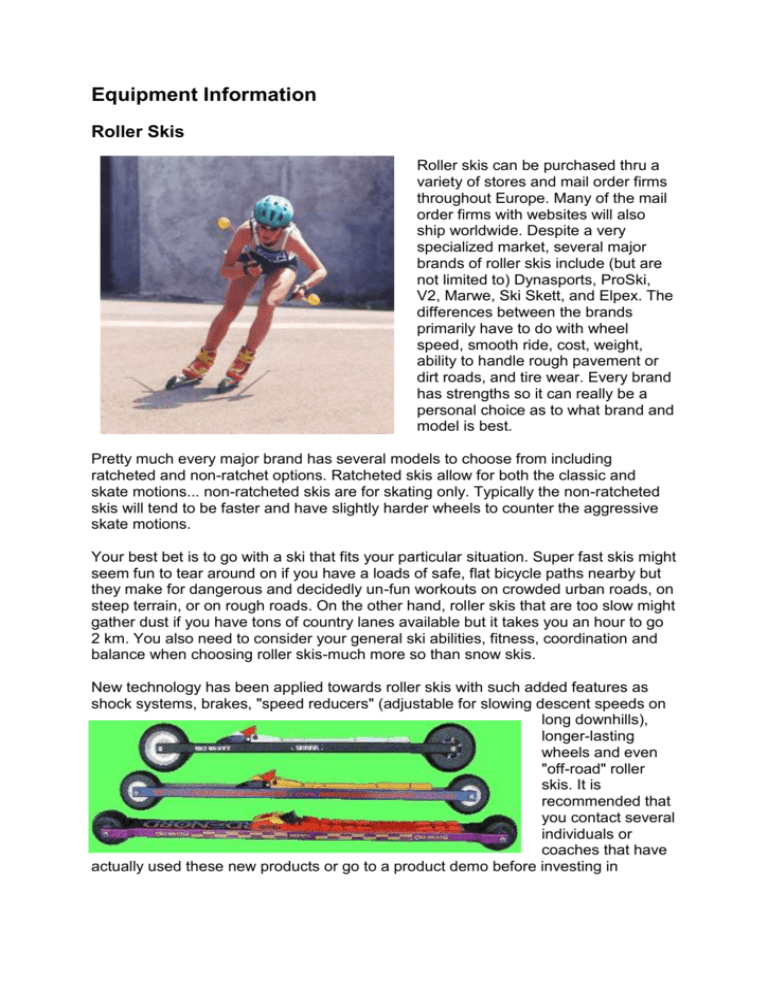
Equipment Information Roller Skis Roller skis can be purchased thru a variety of stores and mail order firms throughout Europe. Many of the mail order firms with websites will also ship worldwide. Despite a very specialized market, several major brands of roller skis include (but are not limited to) Dynasports, ProSki, V2, Marwe, Ski Skett, and Elpex. The differences between the brands primarily have to do with wheel speed, smooth ride, cost, weight, ability to handle rough pavement or dirt roads, and tire wear. Every brand has strengths so it can really be a personal choice as to what brand and model is best. Pretty much every major brand has several models to choose from including ratcheted and non-ratchet options. Ratcheted skis allow for both the classic and skate motions... non-ratcheted skis are for skating only. Typically the non-ratcheted skis will tend to be faster and have slightly harder wheels to counter the aggressive skate motions. Your best bet is to go with a ski that fits your particular situation. Super fast skis might seem fun to tear around on if you have a loads of safe, flat bicycle paths nearby but they make for dangerous and decidedly un-fun workouts on crowded urban roads, on steep terrain, or on rough roads. On the other hand, roller skis that are too slow might gather dust if you have tons of country lanes available but it takes you an hour to go 2 km. You also need to consider your general ski abilities, fitness, coordination and balance when choosing roller skis-much more so than snow skis. New technology has been applied towards roller skis with such added features as shock systems, brakes, "speed reducers" (adjustable for slowing descent speeds on long downhills), longer-lasting wheels and even "off-road" roller skis. It is recommended that you contact several individuals or coaches that have actually used these new products or go to a product demo before investing in something that may or may not deliver as promised. "Off-road" or rough pavement skis Several roller ski companies produce "off-road" or rough pavement roller ski models. However, there are some things potential buyers should note. Off-road roller skis pretty much won't work in sand, grass, gravel, or other soft surfaces. The pneumatic tire versions will give you some roll but the resistance is so great that it would take a very strong skier to get through even 10 minutes of soft surfaces. Where the pneumatic tires do the best is on hard packed dirt and very rough pavement. There the feel is very much like that of skiing mixed with mountain biking. Again, resistance is high compared to fast pavement but if you use flatter terrain you'll find you can skate or classic without problems. In the right conditions, off-road rolling is a blast. Off-road skis can be slow to very slow on good pavement if you don't have the right tires or tire pressure. On some of the off-road skis you'll occasionally hear reports of instability or "high centering". Typically this is due to really rough conditions. The best way to counter this problem is to find a pneumatic tire ski that is as stable as possible plus try using combi or skate boots regardless of which technique you are doing. Note also that it can be tough to V-1 on off-road skis in steep uphills. The resistance combined with the awkward construction of the ski can make that one particular technique/condition mix tough to execute without plenty of practice. V-1 on more gradual hills is usually not a problem and often skaters can get over steep sections by switching to classic for a few strides. Rough road skis are special versions of regular roller skis and are not meant to be "off-road" per se. These skis have wheels that work on pavement ranging from chipseal to cracked/frost heave damage...places your normal skis would have serious problems. Many skiers have reported great results with these versions. One caution...the shaft height is generally not much different than a regular ski so you will high centre or have your wheels lock if you venture on to pavement that is really a wreck. Poles It is perfectly OK to use any pole grip and shaft you would use on snow for roller skiing. If you have really high-priced racing poles, however, you might want to think about investing in some cheap, roll-dedicated poles. Often the best option is to look into poles marketed for roller blading and sold thru a variety of outlets. They usually cost far less than XC ski-specific poles (because they are mass produced in greater quantities and usually made out of aluminium rather than composite materials) and they are usually a bit more durable which is nice if you take a tumble now and then. The only real distinct feature of roller ski poles as opposed to on-snow poles is the tips. Roller ski pole ferrules (tips)--as well as diamond tipped sharpeners-- are available from any outlet selling roller skis. Do NOT use your regular snow baskets for roller skiing if at all possible. The plastic of the basket can easily be broken off and the tips on regular baskets are usually not designed to handle the stress of pavement. On-snow baskets are not cheap and you don't want to throw away £20 on your first attempt at roller skiing. Dedicated roller ski tips are much cheaper than replacing broken baskets and usually offer a more durable tip construction. Bonus Tip: When you get a pair of roller ski ferrules (tips), use some super glue and reinforce the area where the steel tip is imbedded in the plastic/rubber housing. This extends the life of even brand new ferrules. Here's a few suggestions for applying and maintaining pole tips. To take off a winter basket/tip...use a heat gun (or really powerful hair dryer) or steam/boil the basket for a couple minutes over your kitchen stove. Use watersoluble glue to stick on the roller ferrules on the pole shaft and you are set for the summer. Do NOT use super glue or epoxy to put a roller ski ferrule on a pole shaft even if you have dedicated roller ski poles. Ferrules will break occasionally and it will be a royal pain to get them off the shaft if you don't use water-soluble glue. Take the time to sharpen your tips each time you go out. Five minutes of sharpening will prolong the useful life of a ferrule and help prevent the frustration of constant pole slipping. Keep in mind that colder weather makes for harder pavement. You'll want super sharp tips in the fall or if you typically roller ski early in the morning when it is cooler. Try to avoid dragging tips to "brake" on downhills. You'll damage tips and shafts and you are far better off walking down or getting some speed reducers. Boots, Gloves, Protective Gear Your normal winter boots and gloves will work fine for roller skiing although if you plan on doing a ton of rolling you'll go through equipment twice as fast in the summer. Light gloves are necessary otherwise you are looking at tons of hand blisters and soaked gloves when the weather is warm. Now available in at least one prominent brand are dedicated gloves made just for roller skiing. Be forewarned: you'll probably get blisters no matter what the first few times-it does get better when your hands start to toughen up. Vaseline can help somewhat. For protective gear we recommend that roller skiers use, at the very minimum: bright (reflective if possible) clothing, gloves, a bicycle helmet, and some kind of knee protection. It is also a very good idea to use elbow/wrist guards and elbow pads...particularly for beginners and juniors. Every tumble you've ever seen an inline skater take can, and will, happen on roller skis. Keep that in mind! Where And How To Roller Ski Roller skiing's primary drawback compared to winter XC skiing is the relative difficulty for most folks in finding suitable locations. It can take awhile to discover perfect roller skiing spots but if you know what to look for (and when to go) you can discover a whole new dimension to XC skiing. Where To Roller Ski Look for roads or bicycle trails with very low traffic levels, wide shoulders, and good visibility. Often moderate to high use areas can be safe to roller ski very early in the morning or just before dusk. Weekend or holiday early mornings are often ideal times for roller skiing. A location that often is perfect for urban skiers is a modern business park early on a weekend or holiday morning. If the location has any kind of terrain to it you'll often find plenty of good pavement and empty parking lots to cruise around in. Always look into law enforcement protocol regarding roller skis before going out. If in doubt, actually take your skis into a police or highway patrol station and find out what your local Highway Patrol or police department's policies are regarding roller skis. Ask if they have any suggestions for places to go and if they would prefer that you ski facing or with traffic. You'll find that most law enforcement folks will be thrilled you took the time to get their feedback and by following their directions you'll have gained valuable allies if you ever run into some folks that hate to see people out having fun and want to ruin it for everyone. Look for gently rolling terrain or hills with plenty of run out and a moderate slope. Very few skiers have the ability to handle steep and/or twisting descents. We have found the speed reducers offered by a couple different brands are very much worth the additional £20-30 they add to the package price of roller skis. With reducers you can open up significantly more terrain for your training fun. Be aware of how your choice in location and behaviour on roller skis impacts the general skiing community. If you create dangerous situations by skiing in overly aggressive terrain, in heavy traffic, or in locations where roller skiing is prohibited...you are directly and negatively impacting those of us in the ski community that obey local laws and common sense fundamentals. Same goes for roller skiers that are openly rude or flaunt restrictions put in place by landowners or local public agencies. Roller skiing is not backed up by powerful special interest groups like those for off-road vehicles, motorcyclists etc. so if you act like a nugget on roller skis it directly and negatively impacts those of us that obey the rules. Check the pavement. Chip-seal surfaces, lots of big cracks or potholes, piles of leaves/needles, and obstacles such as cattle grates or curbs can all ruin your day. You cannot stop on a six pence with roller skis...ever...so you want things as smooth and free of debris as possible. Forget about skiing in city traffic or even on bicycle paths if they have multiple traffic controls (stop signs, speed bumps, etc.) or even several downhills with stop signs at the bottom. Stick to rural roads and dedicated multi-user paths with long stretches of uninterrupted pavement whenever possible. First-time skiers should practice in a safe area before venturing too far a field. Newly paved parking lots on a Sunday morning are a good bet as long as they are flat and you have permission to be there. An even better place is paved paths surrounding ball fields or parks...the limitation with these paths is you have to go when people are not around and the paths have to be flat enough and long enough to actually get in real ski techniques. Practice getting the feel of the skis; how to turn quickly; how long it takes to come to a stop; and how to bail out to the side. A particularly good drill is to find a grass area right next to pavement and practice an intentional "bail out" from the pavement onto the grass. Go slowly at first and anticipate that the skis will very nearly come to a dead stop when you move from the pavement to the grass. If you move your feet quickly enough in a shuffle or run...even for 3-5 steps...you'll find you can quickly come under control on the grass. Best of all, this drill offers a great deal of what we call "rear end forgiveness" as a mistake just means you'll tumble on the nice, soft grass. The alternative (pavement) is not nearly as pleasant! How To Roller Ski Just about every technique you can do on skis you can do on roller skis-both classic and skating. You'll find that diagonal stride yields a "perfect" kick due to the ratchet in the wheel, which can be a negative situation if you are aiming to improve your technique (you don't want to get to depend on that level of kick which is almost never there on snow!). Note: Most international class skiers rarely practice diagonal technique on roller skis. When they use "classic" technique on roller skis they primarily double pole and double pole kick. When you do see top skiers striding you must keep in mind the physical and technical base these skiers have developed over years of training. Bottom-line: Until you know what a good diagonal kick should feel like, try to stick with double pole and especially double pole kick when classic rolling. On narrow roads it is best to ski with traffic. On roads with wide shoulders--but large amounts of traffic-it is often safer to ski facing traffic. If you are skiing early in the AM or at twilight you should also be aware of sunlight blinding drivers in one direction or another. Best option in those situations is to ski on the side opposite from the "sunblind" driver. Keep your skis and poles in towards your body whenever passing or being passed by cars, bicycles or pedestrians. The best option is just to double pole until you are clear to begin skiing again. The flaring motion of skating plus the fact that most skiers never really hug the curb or shoulder of a road makes you a big concern to drivers if you don't get in the double pole when being passed habit. Two Critical Habits...Always check over your shoulder before skiing into a traffic path or passing another skier. It applies when you have to ski into the traffic lane to avoid a drainage grate, gravel, or other obstacle. Never ski two abreast unless you are on a closed roadway or a very wide, multi-user path with few bicycles or pedestrians. STOPPING-this can be tough. A snowplough wedge is only partially effective as is rapid-fire step turning. They both can work but you wouldn't want to bet your life on them. Skiers that have good balance on roller skis can often use a stepping snowplough whereby the skier steps forward several times one foot at a time in a snowplough position slowly creating a brake action. When done properly this works better than a straight snowplough because you can push harder with each foot on each step and don't burn your wheels as much as regular snowploughing. A good quick-stop combination for intersections is to snowplough or step snowplough heavily AND use your poles to help brake by planting them in front and away from your body several times outside the edge of the pavement. Another tip is to use your body and arms as a "windbreak" standing up as wide as possible to slow things down. Be sure to keep your knees slightly bent while doing this however. The best stopping solution is to roll in areas where you won't ever need to come to sudden stops so that you can let speed diminish naturally before using a partial wedge or your poles to finally stop. Note: Using a snowplough too often will shorten wheel life considerably. Wheels are not cheap to replace so keep that in mind when selecting terrain. Slow down well before and anticipate hazards. You'll learn the hard way if you blast into a dangerous area and find you have to crash to save yourself! Leave the daredevil stunts for Hollywood. Gunning down dangerous hills; running stop signs; weaving thru traffic-these kinds of behaviours force officials to create laws prohibiting roller skiing and lead to expensive (and potentially tragic) accidents. When in doubt, walk down a hill. In "no choice" situations, you can always bail out to the side of the pavement. Try to aim for grass or sand areas and try to just "run" on your skis before giving up and crashing. Training Tips Roller skiing is a very effective snow simulation tool (and even a sport by itself) but you want to keep a few things in mind. First, if you simply can't get comfortable on pavement or around traffic you might be better off doing foot ski simulation instead. A terrified roller skier isn't going to be able to get their heart rate up (maybe via fright but not via training :-) and is far more likely to take a dangerous fall. Conversely, if you are rolling in particularly tough terrain or high altitude you need to make sure your heart rate does not climb too high. It is very easy to get swept up by the speed of roller skiing and forget to monitor your training zones. If you are operating at too high a heart rate with too little experience on roller skis you are more likely to make mistakes, which result in a fall or simply over train yourself. Finally, the biggest benefit roller skiing provides over bounding or running is in the development of technique and endurance strength. To yield the maximum benefit, roller ski workouts must contain a great deal of focused time isolating specific technical areas and muscle groups. Many skiers (of all ages) go out all summer and fall on roller skis and can't figure out why they don't make a huge jump in improvement the next winter. The answer usually lies in too much time rolling with "lazy " technique; always skiing in terrain that is too steep or too flat; and/or generally just "going out" instead of going out with a specific goal in mind. Here are some ways to improve your roller skiing training next time out. Try to avoid using diagonal stride when classic rolling unless you have a clear understanding of and feeling for a "late kick". Instead, concentrate on good double pole, double pole kick motions or skating. Use as much V-2 and V-2 alternate when skating on roller skis as possible. Roadways almost always lack the abrupt transitions of ski trails so take advantage of the opportunity to really build your power gears. Vary your terrain as much as possible. Seek out both flat and rolling terrain sites. Bicycle paths often offer the best technical choices but please watch out for other users! Concentrate on complete motions whenever roller skiing. "Lazy" training will translate into lazy skiing next winter. You don't always have to go hard-but you always want to ski technically well. An hour of focused training with excellent technique is often far superior to two hours of sloppy technique. Specific strength exercises such as skiing without poles, double poling uphill, and single poling uphill are best on gradual slopes with good visibility (to account for traffic and multiple trips up and down) or one very long gradual slope. Aim for strong, snappy motions at moderate to high turnover. Time trials and intervals on roller skis are best on uphill terrain whenever possible or a very safe section of rolling terrain. All out speed on roller skis should only be done by very experienced skiers with proper safety equipment. However, most skiers can benefit from 5-10 second "pick ups" randomly thrown into distance sessions. Concentrate on powerful motions at a reasonable tempo. A good rule of thumb on pick ups is to factor one speed burst for every 15-20 minutes of a distance workout. If you train in a group on roadways, try to have a support vehicle follow you with bright signs warning drivers you are on the roadway. Once again, NEVER ski two-abreast unless you can be fully contained within a designated bicycle lane...and even then, only when other users are few and far between.
